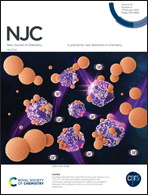A polydopamine modified resin loaded nZVI composite for hexavalent chromium removal from aqueous solution
Abstract
Nanoscale zero-valent iron (nZVI) has attracted widespread attention since it can effectively solve the Cr(VI) pollution problem by reducing Cr(VI) to less toxic and less soluble Cr(III). However, nZVI easily agglomerates and oxidizes. In order to solve these problems, resin D201 was selected as the carrier and modified by polydopamine (PDA) to prepare a PDA/nZVI/D201 composite material to treat simulated Cr(VI) wastewater in this work. SEM, TEM, EDX and BET analyses showed that nZVI particles were uniformly dispersed on the surface of D201 and their surfaces were covered with a PDA film. PDA/nZVI/D201 has a mesoporous structure and its specific surface area was 23.57 m2 g−1. XPS analysis showed that Cr(VI) could be adsorbed on the surface by electrostatic action of protonation of the PDA active site and reduced to Cr(III) by nZVI. Some Cr(III) formed a co-precipitate with Fe(III) and attached to the resin, and some Cr(III) chelated with PDA due to its hydrophilicity and abundant amino and hydroxyl groups. Compared with bare nZVI, PDA/nZVI/D201 significantly improved the removal efficiency of 100 mg L−1 Cr(VI) by 61.1%. The adsorption of Cr(VI) on the PDA/nZVI/D201 composite well followed Langmuir adsorption isotherms and the maximum adsorption capacity reached 184.9 mg g−1. The results show that PDA-modified resin loaded nZVI is a promising method for in situ heavy metal contaminated groundwater remediation.



 Please wait while we load your content...
Please wait while we load your content...